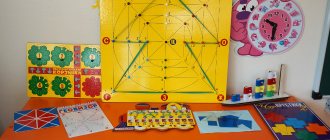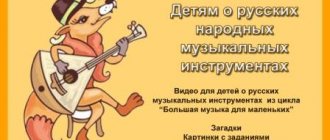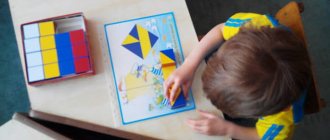Pictures of furniture
At the moment of visual acquaintance with such material, children learn to recognize pieces of furniture. Pronounce their names accurately. Additionally, they gain skills in comparing quantities and proportions.
Pictures on the topic of furniture for children of senior preschool age are motivating material for the development of artistic taste. They help you learn to think figuratively, describing interior items in detail.
Pictures for the puzzle to print
To make a regular puzzle for children with your own hands, just take any picture and cut it into any number of pieces. But with shaped puzzles everything is more complicated.
Sectional pictures of furniture
Pictures of furniture for children in kindergarten can be used in cut form. To do this, the finished colorful images are divided into parts of regular/irregular geometric shape.
Starting from early preschool age, the child is able to match puzzles and put together a picture. The benefits of such activities cannot be overestimated. They contribute to the development of the following functions and abilities:
- logical and spatial thinking;
- fine motor skills, coordination of movements;
- orientation in space;
- making independent decisions;
- fantasy;
- creative skills;
- visual perception of information.
Methodology “Cut pictures” test in correctional pedagogy
Methodology “Cut pictures”
The technique of folding cut pictures is used to study perceptual modeling based on the analysis and synthesis of the spatial relative position of parts of the whole image, the ability to correlate parts and the whole and their spatial coordination, that is, synthesis at the subject level (constructive praxis).
The technique consists of four sets of drawings, each of which consists of three identical images. The images used are color images that have been tested over many years of work: a ball, a pan, a mitten, a coat. In these images, an additional reference point is the background color.
Each of the reference images in the set is not intended to be cut, while the others must be cut along the specified lines. In this case, the images of each set are cut differently and thereby represent tasks of varying complexity. The tasks are complicated not only by the number of “details,” but also by the configuration of the section, as well as the nature of the image itself.
A reference image is placed on the table in front of the child and next to it, in a random order, the details of the same image, but cut up, are laid out. Instructions are usually given in verbal form. The child is asked to put together from the pieces in front of him exactly the same picture as the reference one. Regardless of age, it is advisable to present the picture first, cut in such a way that the child can fold it without difficulty.
After this, it is necessary to present the child with another picture, cut in exactly the same way, to make sure that the task is available for completion.
The presence of four sets allows us to identify not only the current level of development of visual-effective and visual-figurative thinking, but also to assess the child’s learning ability, dosing out help or teaching new types of activities.
Not only the success of implementation is analyzed, but, first of all, the child’s activity strategy.
Analyzed types of activity strategy:
- chaotic, that is, goalless, manipulative activity of the child (without taking into account the effectiveness of his own attempts);
— the “trial and error” method — actions in a visually effective manner, taking into account the trials and errors obtained;
- purposeful execution of a task without a preliminary program or at least visual-spatial assessment;
- execution in a visual-figurative manner with preliminary visual “trying on”, correlating the result and the sample.
Age indicators of task completion. Children aged 3-3.5 years usually cope with the task of folding pictures cut in half. Children aged 4-4.5 years usually cope with the task of folding pictures cut into three equal parts (along the picture or across it), into four equal parts (meaning straight cuts at an angle of 90°). Children aged 5-5.5 years usually cope with the task of folding pictures cut into three to five unequal parts (along the picture and across it) into four equal diagonal parts (meaning straight cuts at an angle of 90°). Children over 5.5-6.5 years of age usually cope with the task of folding pictures cut into five or more unequal parts of various configurations.
Didactic games
Pictures on the topic of furniture for children are often used as visual material for educational games. Their range is varied. Such fun is aimed at the overall development and development of the child as a person.
- “What will this be needed for?” The child needs to correctly name the piece of furniture in the picture and describe its purpose (what they do with it in everyday life, where it can be placed).
- "Find the odd one out." A radically different image is specially added to one of the groups of pictures (by purpose, location, color, size). The child is given the task of determining what is superfluous.
- "Get things in order." In front of the child is a diagram of an apartment with different rooms and chaotically laid out pictures of furniture. The goal is to arrange the furniture in its place, as is customary in real life.
- "Part of an object." In all pictures, the furniture is shown without a certain element (the back of a chair, the armrest of a chair, the leg of a sofa, etc.). Children need to point to the missing part and name it.
- "What common". The task is to find common characteristics among different furniture (elements - legs, backs, etc., or color, shape, material).
- "Find the difference." Children need to find differences in pieces of furniture similar to the previous game.
- “What is this item?” It is required to describe certain furniture with various epithets. Give it a detailed description using adjectives. You can arrange a competition between subgroups of children. The team that comes up with the most characteristics wins.
- “Put it all together.” It is necessary to assemble a piece of furniture from puzzles, an entire furnished room. If there are two identical sets of puzzles, older children can compete in the speed of completing the task.
- "Shop". A child can make a conditional purchase of a headset only if he correctly pronounces the name of the furniture in the picture.
- "Repair". In all pictures, the furniture is shown without a certain element (back, legs, seat, armrest). Children need to name the missing part, what it can be made of and what tools are needed to repair it.
- "What is this". The child needs to recognize and name the furniture based on individual parts of the set.
- "Big small". Invite the children to compare the furniture in the two pictures and determine which is larger and which is smaller.
- “Name all the pieces of furniture.” The image contains chaotically placed furniture, dishes, plants, things, etc. Children find and name only furniture.
- “How this furniture is made.” The child should reproduce the sequence of actions when making an object. To do this, you need to prepare a manual diagram that shows: the material, the manufacturing process, tools and the furniture itself.
- "In our house". The task for kids is to list all the pieces of furniture that they have at home (by room).
If you prepare a variety of pictures of furniture for children, you can come up with any didactic fun on your own. Invent your own unique gaming method of teaching and developing children.
How to use printable assignments
How to work with picture puzzles for children:
- print out the proposed puzzle picture, prepare scissors, and, if desired, a clean sheet of paper and glue;
- Explain the task to the child. That's it, the part for adults is over;
- then completely independent work : cut the puzzle along the contours;
- reassemble the puzzle in the correct order;
- stick on a blank sheet of paper as a finished applique.
Please note that some pictures specifically do not contain lines and patterns flowing from one puzzle element to another. This kind of puzzle is more difficult to assemble; you need to rely only on the shape of the elements, and to do this you need to cut the picture very carefully.







